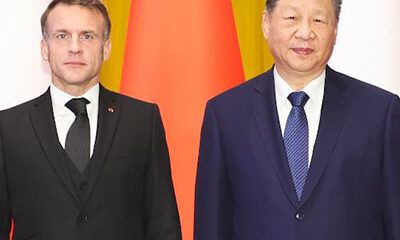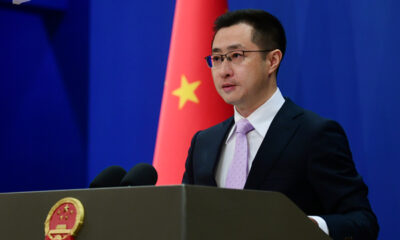Asia
ဘင်္ဂလားဒေ့ရှ်နိုင်ငံ၏ ကျန်းမာရေးစောင့်ရှောက်မှုလုပ်ငန်းတွင် တရုတ်နိုင်ငံ၏ နည်းပညာမြင့်စက်ရုပ်က လူနာများအတွက် အကျိုးပြုလျက်ရှိ
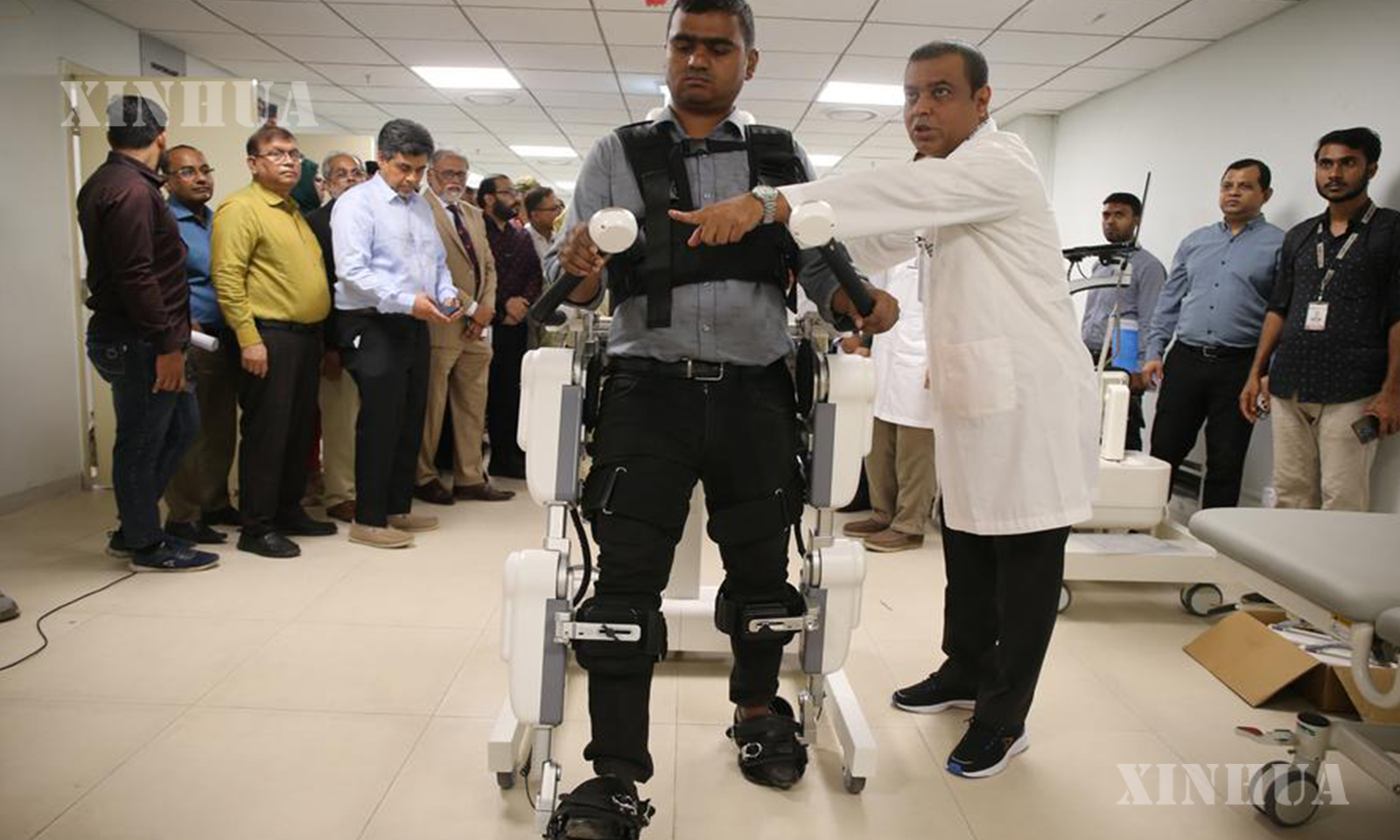
ဒါကာ၊ အောက်တိုဘာ ၂၅ ရက် (ဆင်ဟွာ)
ဘင်္ဂလားဒေ့ရှ်နိုင်ငံ ဒါကာမြို့၌ တည်ရှိသော ဘင်္ဂလားဒေ့ရှ်ဆေးတက္ကသိုလ် (BMU) ၏ အထူးကုဆေးရုံရှိ ဆိတ်ငြိမ်၍ အလင်းရောင်ကောင်းစွာရရှိသည့်အခန်းအတွင်း တိတ်တဆိတ်ပြောင်းလဲမှုများ ဖြစ်ပေါ်လျက်ရှိသည်။ လေဖြတ်ခြင်းကြောင့် တစ်ချိန်က သွားလာလှုပ်ရှားရန်ခက်ခဲသော လူနာတစ်ယောက်မှာ ကုထုံးကျွမ်းကျင်ပညာရှင်များနှင့် စက်ရုပ်အရိုးငြမ်းဝတ်စုံ၏ အထောက်အပံ့ဖြင့် ခြေလှမ်းမှန်မှန် လျှောက်လှမ်းနိုင်ပြီ ဖြစ်သည်။
၂၀၂၀ ပြည့်နှစ်က လိမ့်ကျခဲ့ပြီး ၂၀၂၃ ခုနှစ်တွင် ဦးနှောက်လေဖြတ်ဝေဒနာခံစားခဲ့ရသော အရန်တပ်ဖွဲ့စစ်သည် Abu Sayeed Dewan သည် ကုသရေးဌာနမျိုးစုံ၌ ဆေးကုသမှုခံယူခဲ့သော်လည်း ၎င်း၏အခြေအနေမှာ ကြီးကြီးမားမား တိုးတက်လာမှုမရှိခဲ့ပေ။
နောက်ပိုင်းတွင် ၎င်းအား BMU ၌ အသစ်တည်ထောင်ထားသော စင်တာသို့ လွှဲပြောင်းခြင်းခံခဲ့ရကာ ယင်းနေရာ၌ တရုတ်နိုင်ငံထံမှ နောက်ဆုံးပေါ် စက်ရုပ်နည်းပညာသုံး ကုထုံးစနစ်ဖြစ်သည့် ကိုယ်လက်အင်္ဂါ ပြန်လည်သန်စွမ်းရေးအား အသွင်ပြောင်းလဲမှုကို ထိတွေ့ခဲ့ရသည်။
ယင်းနည်းပညာက Dewan အတွက် လမ်းကြောင်းသစ်ပွင့်စေခဲ့သည်။ “ကျွန်တော့်ရဲ့ ပထမဆုံး လေ့ကျင့်ခန်းလုပ်ပြီးတဲ့နောက် ကျွန်တော့်ရဲ့ ခံစားချက်တွေ ပြောင်းလဲလာတာတွေကို သတိပြုမိခဲ့တယ်” ဟု ၎င်းက တည်ငြိမ်စွာ အလေးထား ပြောဆိုခဲ့သည်။
သိသာထင်ရှားမှုအရှိဆုံး အောင်မြင်မှုမှာ ၎င်း၏ အခြေအနေတိုးတက်မှုနည်းသည့် ဘယ်ဘက်ခြမ်းတွင်ပင်ဖြစ်သည်။ “အဓိကပြဿနာကတော့ ကွေးလို့မရ လှုပ်ရှားလို့မရတဲ့ ကျွန်တော့်ခြေထောက်တွေက ဒီစက်ကိရိယာနဲ့ နည်းနည်းလေးသက်သာလာခဲ့တယ်။ ဒါပေမဲ့ ကျွန်တော် ကောင်းသထက်ပိုကောင်းလာတယ်လို့ ခံစားရတယ်” ဟု ၎င်းက ဆိုသည်။
ဘင်္ဂလားဒေ့ရှ်နိုင်ငံ အနောက်မြောက်ပိုင်း ဘိုဂူရာခရိုင်မှ ရောက်ရှိလာသည့် နောက်ထပ်လူနာတစ်ဦးဖြစ်သူ Ariful Islam သည် ခြေထောက်နှစ်ဖက်လုံး ခြေထောက်သိုင်းကျရောဂါ ခံစားနေရကာ လမ်းလျှောက်ရန် ခွန်အားမရှိသည့် အခြေအနေနှင့် ရင်ဆိုင်နေရသူဖြစ်သည်။
“အကြောအဆစ်ဌာနမှာ ကျွန်တော်စဆေးရုံတက်လိုက်တဲ့အခိုက်အတန့်ကတည်းက လုပ်ကိုင်နည်းလမ်းတွေက အတိုင်းထက်လွန်ပါပဲ” ဟု ၎င်းကိုယ်တိုင်ကုသမှုခံယူခဲ့ရသည့် ရောဂါရှာဖွေစစ်ဆေးမှုများနှင့် ဂရုတစိုက်စောင့်ရှောက်ပေးမှုများအပေါ် အမှတ်ရလျက် Ariful က ပြောပြခဲ့သည်။ “ဒီလိုမျိုး အရည်အသွေးမြင့်မားတဲ့ ကုသနည်းတွေကို ကျွန်တော် ပထမဆုံးကြုံတွေ့ဖူးတာပါပဲ။ တကယ့်ကို အထင်ကြီးလောက်စရာပါပဲဗျာ”
“ဒီလိုမျိုးခေတ်မီတဲ့ စောင့်ရှောက်မှုမျိုးနဲ့ဆိုရင်တော့ ကျွန်တော် ပြန်လည်နေကောင်းလာပြီး အိမ်ကိုတောင်ပြန်နိုင်ဖို့ မျှော်လင့်ပါတယ်” ဟု အနာဂတ်ကို မျှော်လင့်စောင့်စားလျက် Ariful က ပြောခဲ့သည်။
တရုတ်နိုင်ငံက တည်ဆောက်ထားသော အဆိုပါစင်တာသည် ဘင်္ဂလားဒေ့ရှ်နိုင်ငံ၏ ပထမဆုံး စက်ရုပ်နည်းပညာသုံး ကိုယ်လက်အင်္ဂါပြန်လည်သန်စွမ်းရေးစင်တာတစ်ခု ဖြစ်ပြီး ယင်းနိုင်ငံ၏ ကျန်းမာရေးစောင့်ရှောက်မှုအတွက် ပန္နက်ရိုက်ပေးလိုက်သော သမိုင်းမှတ်တိုင်လည်း ဖြစ်သည်။ ယင်းစင်တာသည် ဘင်္ဂလားဒေ့ရှ်နိုင်ငံ၏ အဆင့်အမြင့်ဆုံး ရုပ်ပိုင်းဆိုင်ရာပြန်လည်နာလန်ထူရေးဌာနအဖြစ် လျင်မြန်စွာပြောင်းလဲတိုးတက်လာခဲ့သည်။ ထို့ပြင် ထိုစင်တာသည် သမားရိုးကျနည်းလမ်းများ၏ ကြီးမားသောခုန်ပျံကျော်လွှားတိုးတက်မှုကို ကိုယ်စားပြုသလို မရေမတွက်နိုင်သော လူနာများအတွက် မျှော်လင့်ချက်မီးပြတိုက်လည်း ဖြစ်လာခဲ့သည်။
တရုတ်နိုင်ငံအစိုးရသည် အဆင့်မြင့်စက်ကိရိယာ ၈၀ ကျော် လှူဒါန်းခဲ့ပြီး ယင်းအနက်အချို့မှာ ဉာဏ်ရည်တုနည်းပညာဖြင့် လည်ပတ်လုပ်ကိုင်လျက်ရှိသည်။ တရုတ်နိုင်ငံမှ ဇီဝဆေးဝါး အင်ဂျင်နီယာအဖွဲ့က BMU ၏ အထူးကုဆေးရုံရှိ ဆရာဝန်နှင့် ရုပ်ပိုင်းဆိုင်ရာကုထုံးဆရာ ၂၀ ကျော်အား လေ့ကျင့်သင်ကြားပေးခဲ့ပြီးဖြစ်ကြောင်း သိရသည်။
BMU ၏ အကြောအဆစ်နှင့် ကိုယ်လက်အင်္ဂါပြန်လည်သန်စွမ်းရေးဌာန၊ တွဲဖက်ပါမောက္ခ Ziaur Rahman Chowdhury က ကနဦးလူများက “ဒီကုသနည်းနဲ့ပတ်သက်ပြီးတော့ တော်တော်လေးကို စိတ်ကျေနပ်မှုရရှိခဲ့ကြတယ်” ဟု ဆိုသည်။ ၎င်းတို့၏ကုသမှုကို “နေ့စဉ် လူနာအယောက် ၂၀ ကနေ ၃၀ အထိ” ကုသပေးနိုင်ရန် ရည်ရွယ်ထားကြောင်း ပြောကြားခဲ့သည်။
အဆိုပါ စင်တာသည် တန်ဖိုးကြီး စက်ရုပ်နည်းပညာသုံး ကိုယ်လက်အင်္ဂါပြန်လည်သန်စွမ်းရေးကို ပိုမိုလက်လှမ်းမီလာစေပြီး “ဆေးကုသစရိတ်တွေကိုလည်း လျော့နည်းစေမည့်အပြင် သာမန်ပြည်သူများကိုလည်း အထောက်အကူပြုနိုင်မည်” ဖြစ်ကြောင်း Chowdhury က ပြောကြားခဲ့သည်။ (Xinhua)
သတင်းအပြည့်အစုံကို ဖော်ပြပါလင့်ခ်တွင် ဝင်ရောက်ဖတ်ရှုနိုင်ပါသည်။ xhtxs.cn/7Hu
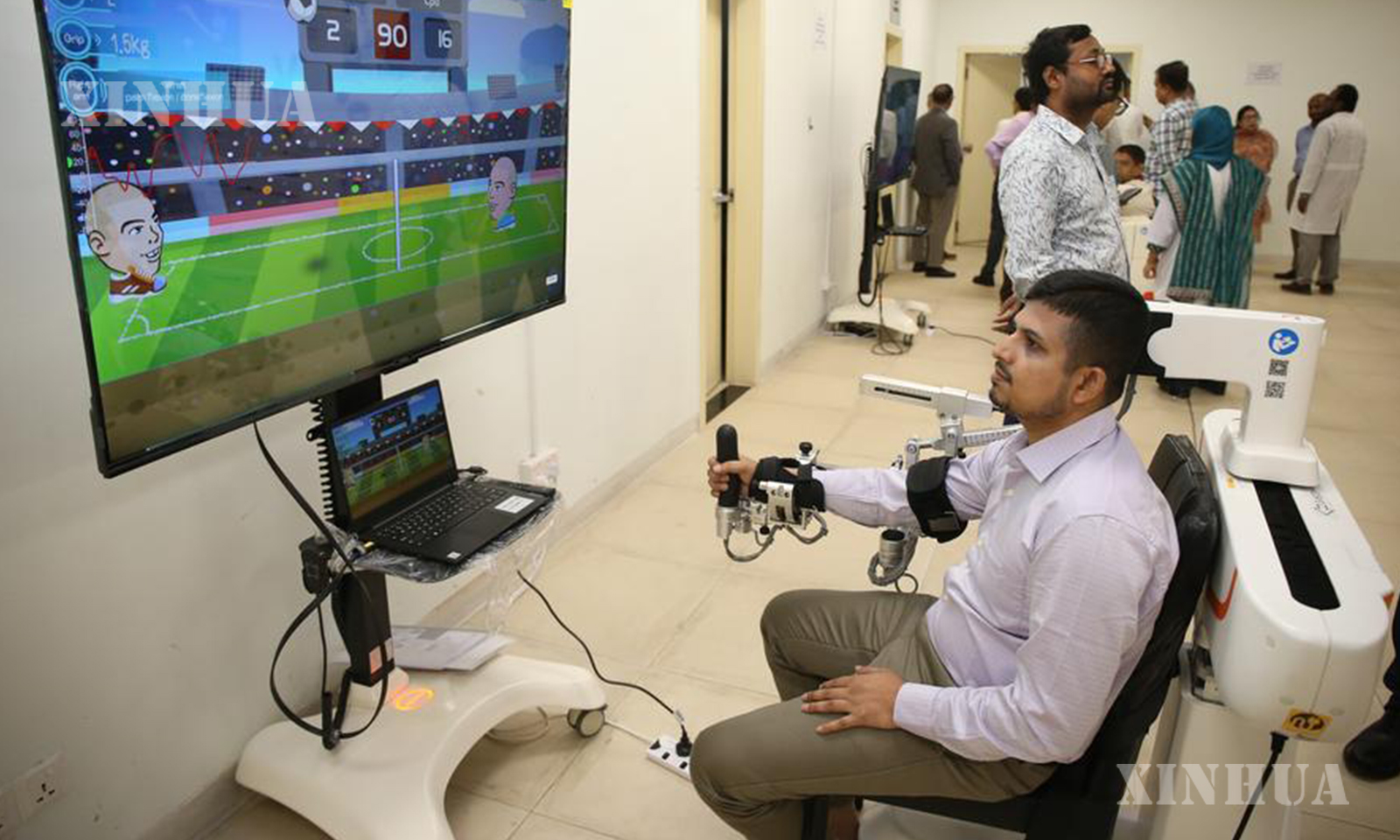
ဘင်္ဂလားဒေ့ရှ်နိုင်ငံ ဒါကာမြို့ ဘင်္ဂလားဒေ့ရှ်ဆေးတက္ကသိုလ် (BMU) ရှိ စက်ရုပ်နည်းပညာသုံး ပြန်လည်သန်စွမ်းရေးစင်တာတွင် ကုထုံးကိရိယာအား လက်တွေ့စမ်းသပ်နေသူတစ်ဦးကို ၂၀၂၅ ခုနှစ် ဩဂုတ် ၃၁ ရက်က တွေ့ရစဉ် (ဆင်ဟွာ)
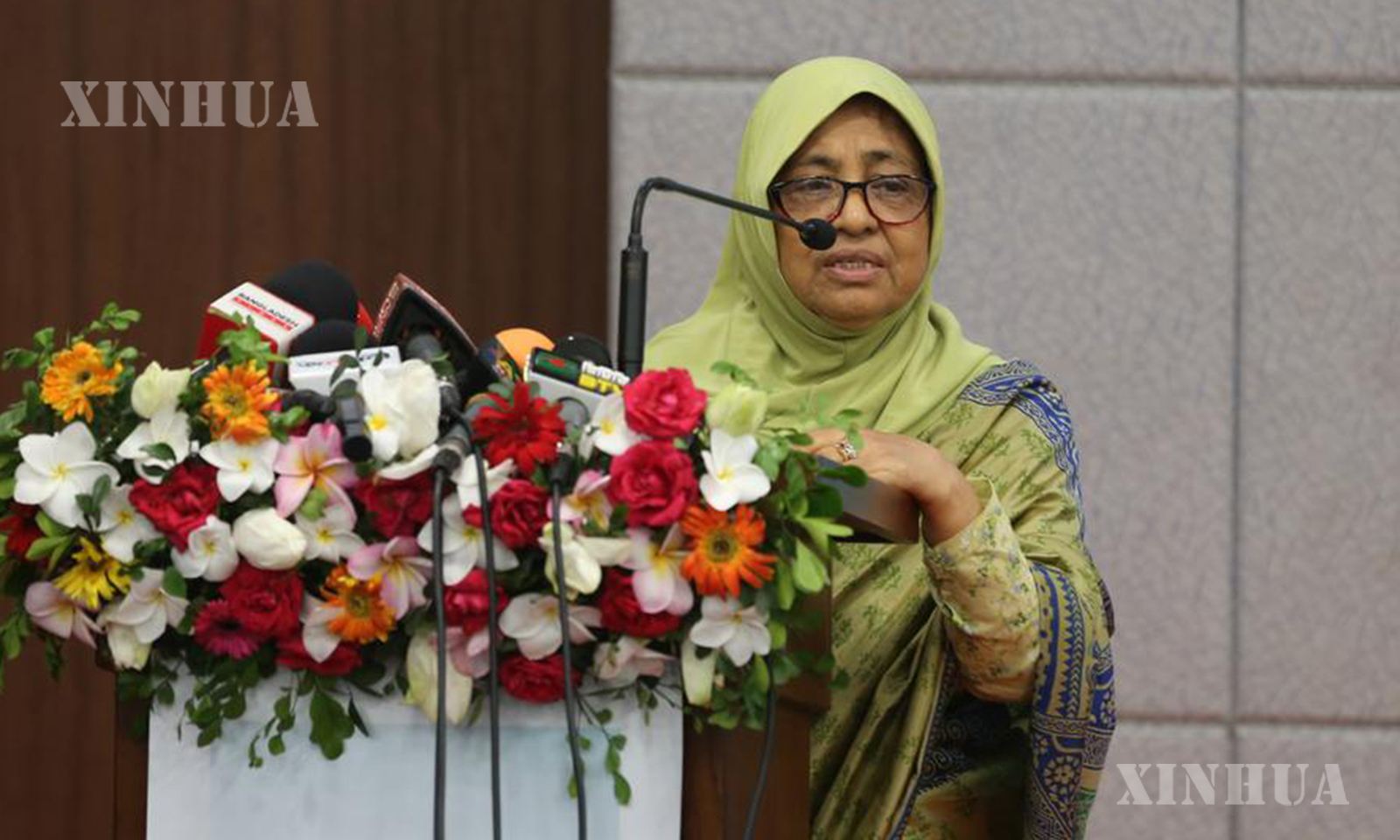
………………………..
(English Version)
China’s high-tech robot in Bangladesh’s healthcare boon for patients
DHAKA, Oct. 24 (Xinhua) — In a quiet and bright room at the Super Specialized Hospital of Bangladesh Medical University (BMU) in Dhaka, a silent revolution was taking place. A patient, once limited by the aftermath of a stroke, took a deliberate step, supported not just by a therapist, but by a sophisticated robotic exoskeleton.
Abu Sayeed Dewan, a paramilitary soldier who suffered from a fall in 2020 and a brain stroke in 2023, said that he was treated at different facilities, but his condition didn’t improve a lot.
Subsequently, he was referred to the newly established center at the BMU, where he was introduced to a revolutionary form of rehabilitation, a state-of-the-art robotic therapy system from China.
This technology offered a new path for Dewan. “After my very first session, I noticed differences in how I felt,” he said, a note of awe breaking through his measured tone.
The most tangible victory was on his left side, where progress had been most stubborn. “A specific problem where I couldn’t bend or move my leg has been alleviated a little by this machine. But I am feeling better and better.”
Another patient Ariful Islam, who came from Bogura district in the country’s northwest, faced the situation of foot drop in both legs and a frightening loss of strength.
“From the moment I was admitted to the physical medicine department, the approach has been excellent,” Ariful said, reflecting on the battery of diagnostic tests and the careful attention he received. “This is my first experience witnessing such high-quality treatment, and I’m truly impressed.”
Looking toward the future, Ariful said, “With this sophisticated care, I am hopeful that I will recover and eventually be able to return home.”
This Chinese-built center is Bangladesh’s first-ever robotic rehabilitation center, a facility that marks a ground-breaking milestone for the nation’s healthcare. The center has swiftly established itself as the country’s most advanced unit for physical recovery. It represents a quantum leap from conventional methods, offering a beacon of hope for countless patients.
The Chinese government has donated more than 80 advanced equipment, and some are powered by artificial intelligence. A team of biomedical engineers from China has already trained over 20 doctors and physiotherapists of the Super Specialized Hospital of BMU.
Ziaur Rahman Chowdhury, associate professor of the Physical Medicine and Rehabilitation Department in BMU, said that the initial patients are “highly satisfied about the treatment,” and their goal is to eventually treat “daily 20 to 30 patients.”
Chowdhury said that this center would make expensive robotic rehabilitation more accessible, as “the expense of the treatment will reduce, and it will be helpful for our general people.” xhtxs.cn/7Hu
Photo 1: A patient receives treatment at the robotic rehabilitation center at Bangladesh Medical University (BMU), Dhaka, Bangladesh, Aug. 31, 2025. (Photo by Habibur Rahman/Xinhua)
Photo 2: A patient experiences a therapeutic equipment at the robotic rehabilitation center at Bangladesh Medical University (BMU), Dhaka, Bangladesh, Aug. 31, 2025. (Photo by Habibur Rahman/Xinhua)

